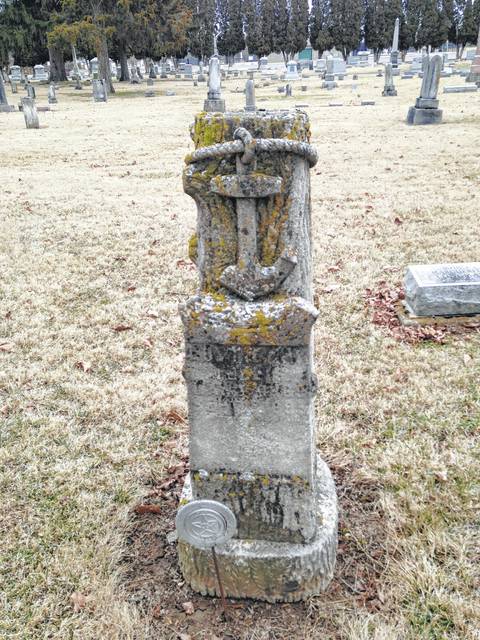
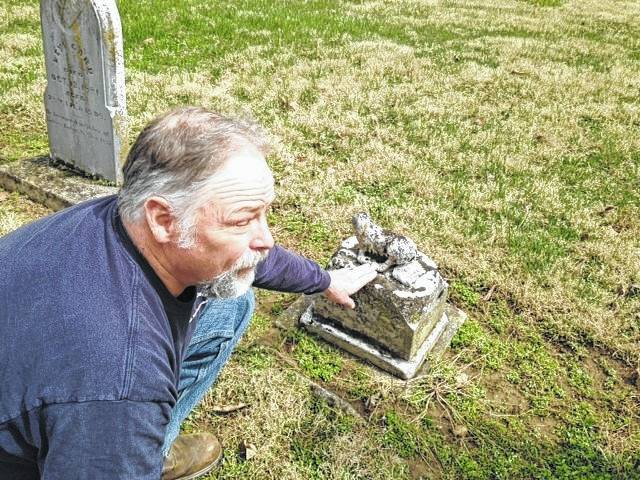
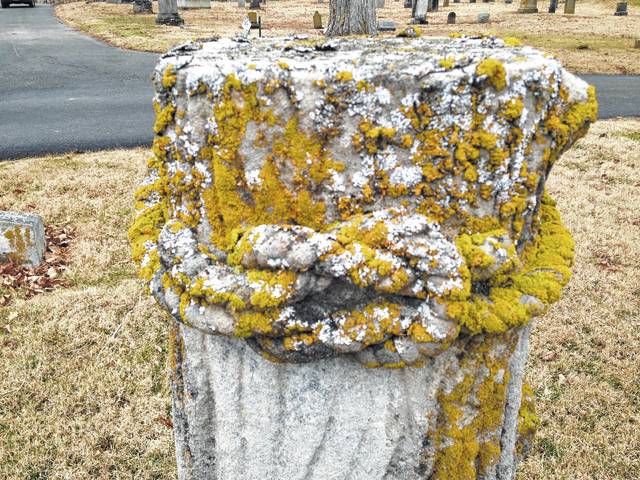
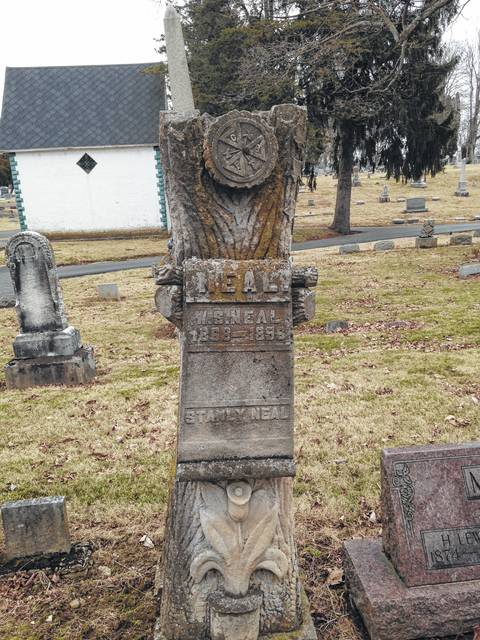
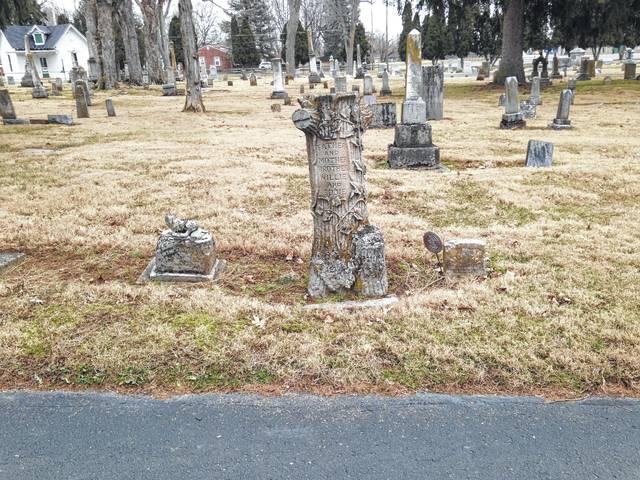
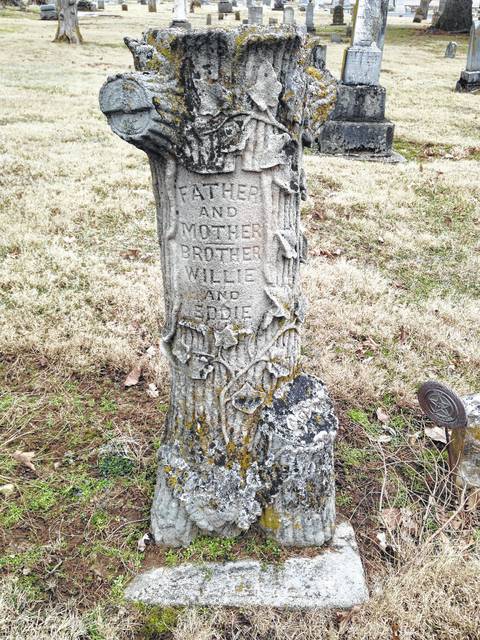
PREBLE COUNTY — A tree is felled; a stump remains. A person dies and is buried; a tombstone marks the spot.
These facts of life converged in our region just before and after the turn of the 20th century to inspire limestone carvers to fashion unique family tombstones shaped as tree stumps. The idea that a life cut short was like a tree chopped down was popular when these tombstones were carved, but their popularity also may have been just fashion of the times.
Eaton’s Mound Hill Cemetery is home to several examples of these traditional grave markers, but many of their inscriptions have become hard to read.
One large embellished stone tree stump can be easily seen from the cemetery drive. It is inscribed to “Father and Mother; Brother Willie and Eddie.” No surname is easily visible on the 4-foot-high stone, but it sits just north of a much smaller, modest USS Navy stone for Joshua Ware, and just south of a weathered small stone with a lamb carved on top – an icon frequently used to mark a child’s grave.
Although no organized records exist for Mound Hill burials before 1930, cemetery Sexton Brad Duke is an expert at deciphering obscured names on the stones. He can see Willie’s name on the child’s stone, and can even make out the Ware family name on the main marker. He also thinks that Joshua Ware’s stone reflects his Civil War service.
Other limestone tree stumps can be found in the western sections of the cemetery, and most can still be at least partially read — with a little effort.
One of the more legible is a stone carved into a simple short stump, with a slightly tilted top that is polished and gives the names and dates a Mr. and Mrs. Sherkey. The name of “Mary J, his wife” is easily read, but Mr. Sherkey’s first name has been obscured by time. However, a 1992 book on the cemetery compiled by Joan Bake Brubaker of West Alexandria gives his first name as Gideon. He was born in 1818 and died in 1912. Mary Sherkey was born in 1822 and died in 1887.
A different style of tree-stump tombstone – one that features one log placed horizontally atop another, larger stump – tilts to the side but still clearly records three interments of the Ashinger family. An easily read inscription shows that Nannie Ashinger was born in 1827 and died in 1910. A more obscured record remembers Lydia (1863-1883). The name Frederick with his dates – 1819-1883 – is even more faded but has not yet disappeared.
Some tree-stump stones can trace their history to the 1890 founding of the Woodmen of the World, a burial fraternity that in recent years has evolved into the WoodmenLife insurance company.
A lovely 6-foot tall stone prepared for the Neal family has carved at its base a potted lily, and on the end of one horizontal stone log, a circular Woodman symbol featuring a sword, an axe and a hatchet, and the letters C, F and B, each within a triangle. W.S. Neal, whose dates are recorded as 1868-1898 worked as a barber, according to Brubaker. (The name Stanley Neal also appears on the stone, but no dates are recorded for him.)
Many of the stones are carved with symbols, which are powerful ways to communicate important beliefs while still leaving room for interpretation. The lily on the Neal stone is usually considered a symbol for resurrection, but it can also stand for the Virgin Mary, humility and purity.
Ivy, carved on stones such as Ware monument, is an evergreen and so can stand for eternal life, or for fidelity or even Jesus’ crown of thorns.
Perhaps the most distinctive tree stump at Mound Hill is one whose writing is difficult to read but which has an anchor seemingly held in place with a stone rope “tied” at the back of the monument with a sturdy knot. Susanne Ridlen’s book Tree-stump Tombstones cites a verse from Hebrews 6 to explain the anchor’s meaning of steadfastness, but it can also stand for hope, and some people think it was a cryptic symbol for the cross in early Christianity.
Just as a tree stump erodes and eventually returns to the earth, so, too, will limestone weather away, although much slower pace. Duke has taken care of Mound Hill for 25 years. He emphasizes that the cemetery does purchase the stones and does not own them. Still, he says, the old markers have become the cemetery’s responsibility, and the staff will maintain them “within reason,” such as occasionally shoring up a badly leaning marker.
In some contexts, the weathering of marker can be seen as a problem. In fact, more than 8,000 World War II military monuments in France were in such bad shape they needed to be replaced before the 70th anniversary of D-Day in 2014, according to the Daily Mail newspaper.
Replacement is not in Mound Hill’s near future. The cemetery staff doesn’t clean the stones of the lichen that cover them, and Brad Duke is one who finds it fitting that the stones age – and look their age.
Judi Hetrick, a retired journalism professor and a folklorist, would love to hear from people in Preble County about their family, neighborhood or community traditions. Please e-mail [email protected], or leave a phone message with The Register-Herald.







